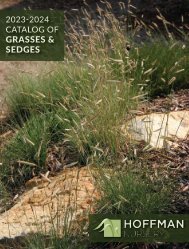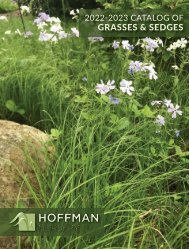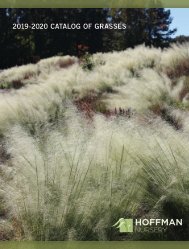2021-2022 Hoffman Nursery Catalog of Grasses
- No tags were found...
Create successful ePaper yourself
Turn your PDF publications into a flip-book with our unique Google optimized e-Paper software.
PENNISETUM<br />
PENNISETUM<br />
With flowing, fountain shapes, and lovely bottlebrush plumes, Pennisetum feature a timeless style.<br />
Fountain grasses look spectacular in masses, as specimens, and in containers. They thrive in hot,<br />
humid summers and require little maintenance. Some reseed, so keep an eye out for seedlings.<br />
Plant at least a month before first frost to get them established; well-drained soils in winter give<br />
best survivability. Results <strong>of</strong> phylogenetic analysis have changed the familiar Pennisetum to the<br />
genus Cenchrus. P. alopecuroides is now Cenchrus purpurascens, and P. orientale is Cenchrus<br />
orientalis. For expediency, we’ll continue listing it under its more recognizable name. See our<br />
comparison chart on page 70 to find the best Fountain Grass for your needs.<br />
Pennisetum alopecuroides<br />
FOUNTAIN GRASS<br />
A graceful favorite with lovely, blush-colored<br />
bottlebrush plumes that appear midsummer and<br />
provide months <strong>of</strong> beauty. Blooms turn a magnificent<br />
almond color in autumn. Size, clumping<br />
habit, and texture beautify borders and massed<br />
plantings. Tolerant <strong>of</strong> poor soil, heat, and sun.<br />
Needs little care once established.<br />
Warm season, green, 3’, 4’ with blooms, sun, dryaverage,<br />
flowers midsummer, Zones 5-9, Origin:<br />
Eastern Asia to Western Australia<br />
Pennisetum alopecuroides<br />
Pennisetum alopecuroides ‘Burgundy<br />
Bunny’ PP21917<br />
DWARF FOUNTAIN GRASS<br />
Sports red highlights in summer and intense<br />
burgundy fall color. Petite, midsummer bottlebrush<br />
plumes rise a bit above the foliage. Grows<br />
in a compact 1’ mound. Beautiful in containers,<br />
borders, and foregrounds. Excellent for<br />
small spaces. Lorne Blackman <strong>of</strong> Walla Walla,<br />
Washington, discovered this natural mutation<br />
<strong>of</strong> ‘Little Bunny’. Unauthorized propagation<br />
prohibited.<br />
Warm season, green (red highlights), 1’, 1.5’ with<br />
blooms, sun-part shade, dry-average, flowers<br />
midsummer, Zones 6-10, Origin: Eastern Asia to<br />
Western Australia<br />
Pennisetum alopecuroides ‘Burgundy Bunny’ PP21917<br />
68 We grow good grass! ®










